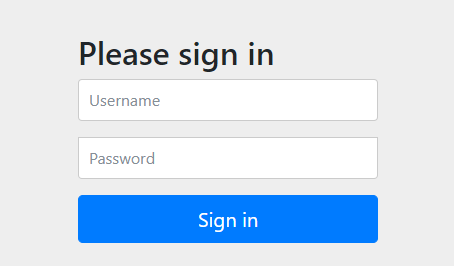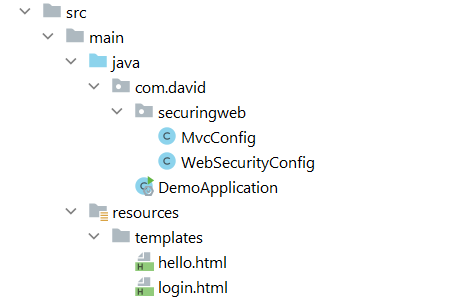SpringSecurity是一个安全框架,使用它可以让我们的系统变得安全一点,它可以对登陆系统的用户进行验证和授权
一个安全的系统需要做的事情很多,比如:防SQL注入、XSS攻击、CSRF等等,
还需要对每一个登陆系统的用户进行权限认证,即决定了每个用户能做什么、不能做什么
在权限管理之前,还得对用户进行授权,授权后根据权限区分用户
授予和权限认证就是SpringSecurity主要做的事情
很重要的一点是,在SpringBoot中使用,可以让原本对开发者来说复杂的SpringSecurity变得简单易用
当然SpringSecurity也有很明显的缺点,就是导入依赖之后,就默认实现了很多奇奇怪怪的东西,让人感觉莫名其妙
这里是直接在SpringBoot中集成的
<dependency> <groupId>org.springframework.boot</groupId> <artifactId>spring-boot-starter-security</artifactId> </dependency> <dependency> <groupId>org.springframework.security</groupId> <artifactId>spring-security-test</artifactId> <scope>test</scope> </dependency>
2、创建一个Controller类测试一下,所以还要导入web依赖包
SecretController.java
1 import org.springframework.web.bind.annotation.GetMapping; 2 import org.springframework.web.bind.annotation.RestController; 3 4 @RestController 5 public class SecretController { 6 @GetMapping("/secret") 7 public String getSecret(){ 8 return "this is secret"; 9 } 10 }
然后运行项目我们直接访问 http://localhost:8080/secret ,会发现页面重定向了,跳转到了一个登陆页面
我们甚至没有设置登陆用户名和密码

这个地方SpringSecurity默认的用户名是user,密码是动态生成的,在日志中会显示
这就是SpringSecurity强大的地方,仅仅是导入了依赖包,就默认进行了登陆验证,当然这也是弊端,因为我们根本不知道它是怎么配置的。
上面是SpringSecurity为我们默认配置的一个登陆页面,下面我们自己进行配置
这里是整个例子的文件结构还有pom.xml,以及使用了thymeleaf,所以要导入依赖
文件结构

pom.xml
1 <?xml version="1.0" encoding="UTF-8"?> 2 <project xmlns="http://maven.apache.org/POM/4.0.0" 3 xmlns:xsi="http://www.w3.org/2001/XMLSchema-instance" 4 xsi:schemaLocation="http://maven.apache.org/POM/4.0.0 http://maven.apache.org/xsd/maven-4.0.0.xsd"> 5 <modelVersion>4.0.0</modelVersion> 6 7 <groupId>org.example</groupId> 8 <artifactId>SecurityTest</artifactId> 9 <version>1.0-SNAPSHOT</version> 10 11 <parent> 12 <groupId>org.springframework.boot</groupId> 13 <artifactId>spring-boot-starter-parent</artifactId> 14 <version>2.5.2</version> 15 </parent> 16 17 <dependencies> 18 <dependency> 19 <groupId>org.springframework.boot</groupId> 20 <artifactId>spring-boot-starter-web</artifactId> 21 </dependency> 22 23 <dependency> 24 <groupId>org.springframework.boot</groupId> 25 <artifactId>spring-boot-starter-thymeleaf</artifactId> 26 </dependency> 27 28 <dependency> 29 <groupId>org.springframework.boot</groupId> 30 <artifactId>spring-boot-starter-security</artifactId> 31 </dependency> 32 </dependencies> 33 34 <properties> 35 <maven.compiler.source>8</maven.compiler.source> 36 <maven.compiler.target>8</maven.compiler.target> 37 </properties> 38 39 </project>
首先我们要自己创建一个login页面,以及登录以后访问的页面
login.html
1 <!DOCTYPE html> 2 <html xmlns="http://www.w3.org/1999/xhtml" xmlns:th="https://www.thymeleaf.org" 3 xmlns:sec="https://www.thymeleaf.org/thymeleaf-extras-springsecurity3"> 4 <head> 5 <title>Spring Security Example </title> 6 </head> 7 <body> 8 <div th:if="${param.error}"> 9 Invalid username and password. 10 </div> 11 <div th:if="${param.logout}"> 12 You have been logged out. 13 </div> 14 <form th:action="@{/login}" method="post"> 15 <div><label> User Name : <input type="text" name="username"/> </label></div> 16 <div><label> Password: <input type="password" name="password"/> </label></div> 17 <div><input type="submit" value="Sign In"/></div> 18 </form> 19 </body> 20 </html>
hello.html
1 <!DOCTYPE html> 2 <html xmlns="http://www.w3.org/1999/xhtml" xmlns:th="https://www.thymeleaf.org" 3 xmlns:sec="https://www.thymeleaf.org/thymeleaf-extras-springsecurity3"> 4 <head> 5 <title>Hello World!</title> 6 </head> 7 <body> 8 <h1 th:inline="text">Hello [[${#httpServletRequest.remoteUser}]]!</h1> 9 10 </body> 11 </html>
然后再MVC里面配置一下这两个页面,才可以通过url进行访问,MVC的配置需要实现WebMvcConfigurer接口
MvcConfig.java
1 import org.springframework.context.annotation.Configuration; 2 import org.springframework.web.servlet.config.annotation.ViewControllerRegistry; 3 import org.springframework.web.servlet.config.annotation.WebMvcConfigurer; 4 5 @Configuration 6 public class MvcConfig implements WebMvcConfigurer { 7 8 @Override 9 public void addViewControllers(ViewControllerRegistry registry) { 10 11 registry.addViewController("/").setViewName("login"); 12 registry.addViewController("/hello").setViewName("hello"); 13 registry.addViewController("/login").setViewName("login"); 14 } 15 }
然后我们需要进行SpringSecurity的配置,定义页面访问请求时,用户需要哪些权限,需要继承WebSecurityConfigurerAdapter类进行配置
现在配置中自己定义了一个用户(在实际项目中从数据库获取),而不再是由SpringSecurity默认定义
WebSecurityConfig.java
1 import org.springframework.context.annotation.Bean; 2 import org.springframework.context.annotation.Configuration; 3 import org.springframework.security.config.annotation.web.builders.HttpSecurity; 4 import org.springframework.security.config.annotation.web.configuration.EnableWebSecurity; 5 import org.springframework.security.config.annotation.web.configuration.WebSecurityConfigurerAdapter; 6 import org.springframework.security.core.userdetails.User; 7 import org.springframework.security.core.userdetails.UserDetails; 8 import org.springframework.security.core.userdetails.UserDetailsService; 9 import org.springframework.security.crypto.bcrypt.BCryptPasswordEncoder; 10 import org.springframework.security.crypto.password.PasswordEncoder; 11 import org.springframework.security.provisioning.InMemoryUserDetailsManager; 12 13 @Configuration 14 @EnableWebSecurity 15 public class WebSecurityConfig extends WebSecurityConfigurerAdapter { 16 /* 17 @EnableWebSecurity注解让springsecurity集成springmvc 18 */ 19 @Override 20 protected void configure(HttpSecurity http) throws Exception { 21 /* 22 定义了哪些路径访问是需要权限的,哪些不用 23 /和/login两个url是不需要权限就可以访问的 24 /hello需要有“USER”权限才能够访问 25 */ 26 http.authorizeRequests() 27 .antMatchers("/hello") 28 .hasRole("USER") 29 .and() 30 .formLogin() 31 .loginPage("/login") 32 .permitAll(); 33 } 34 35 36 @Bean 37 public PasswordEncoder passwordEncoder(){ 38 /* 39 声明一个加密工具的Bean,供用户进行加密时调用 40 */ 41 return new BCryptPasswordEncoder(); 42 } 43 44 @Bean 45 @Override 46 protected UserDetailsService userDetailsService() { 47 /* 48 设置了一个预先存储在系统中的用户 49 赋予用户“USER”角色权限,才能够访问hello页面 50 */ 51 String username = "user"; 52 String password = "password"; 53 UserDetails user = User.withUsername(username).password(new BCryptPasswordEncoder().encode(password)).roles("USER").build(); 54 return new InMemoryUserDetailsManager(user); 55 } 56 }
现在运行项目,在没有登录之前,访问/hello会被重定向到login页面,登录之后就能访问hello页面了
如果把上面代码里,用户的角色权限“USER”改成其他的,登录之后访问\hello则会抛出403错误,因为权限不够
原文:https://www.cnblogs.com/davidFB/p/15128649.html